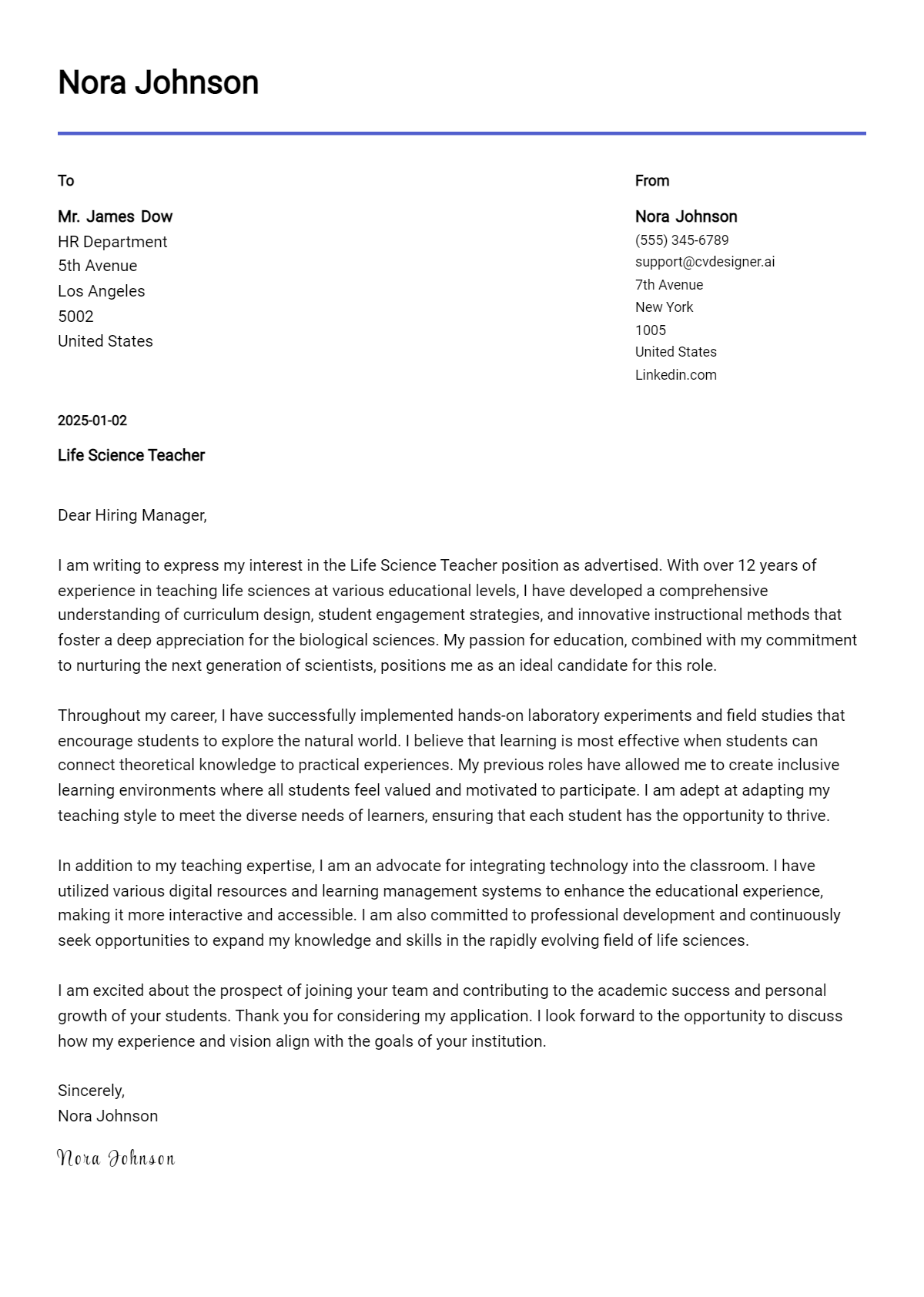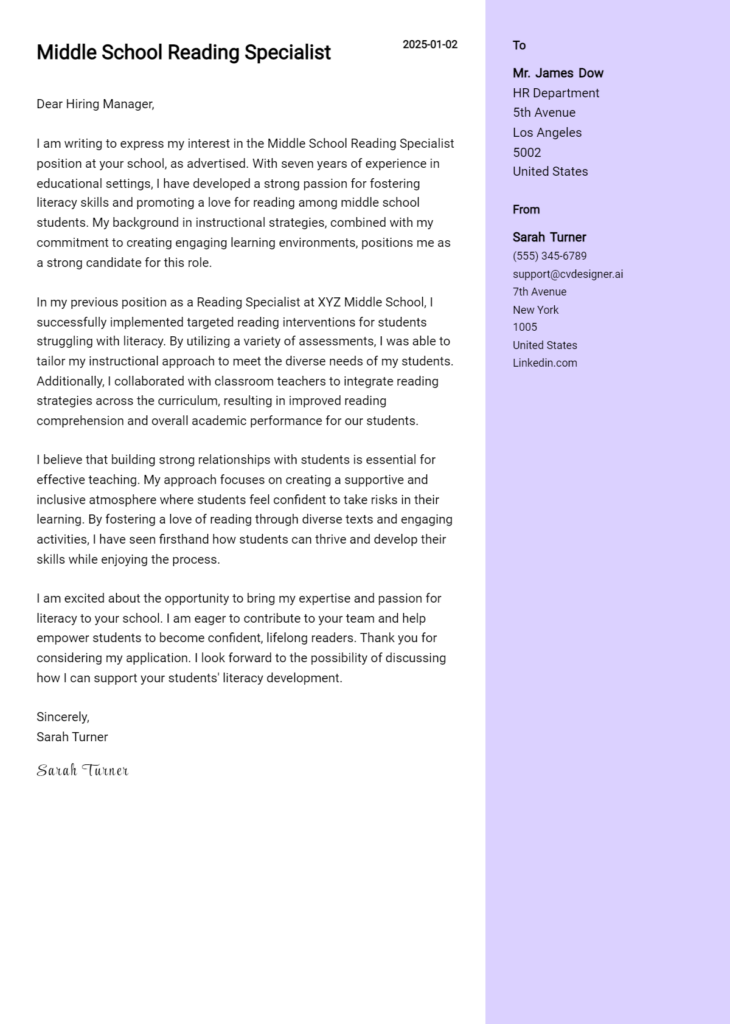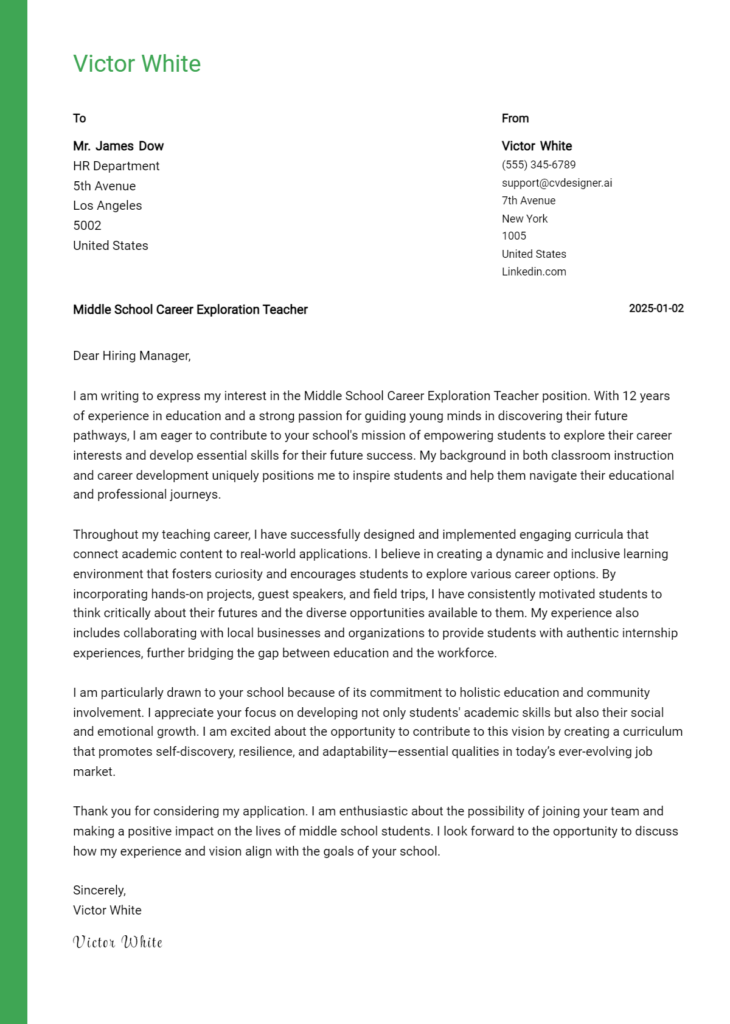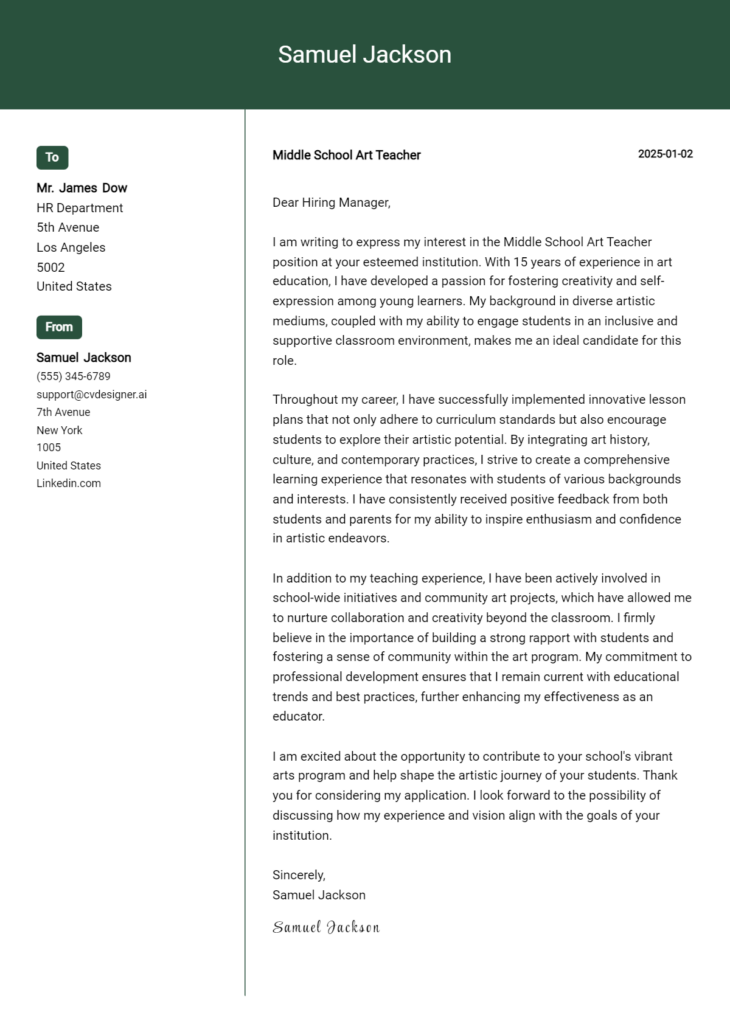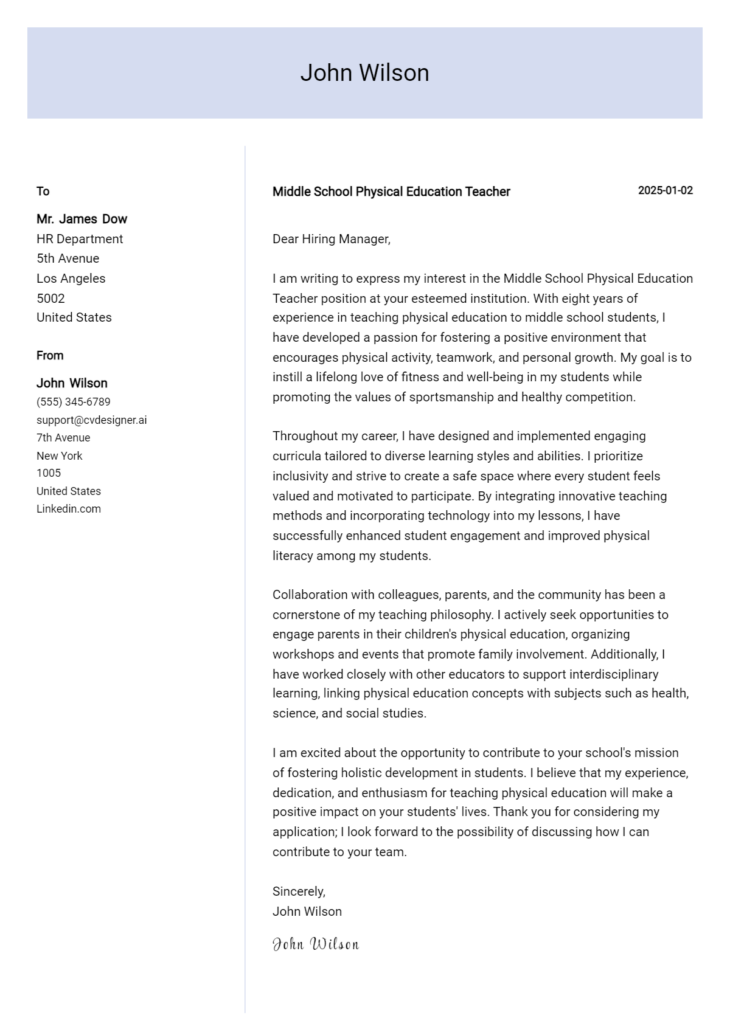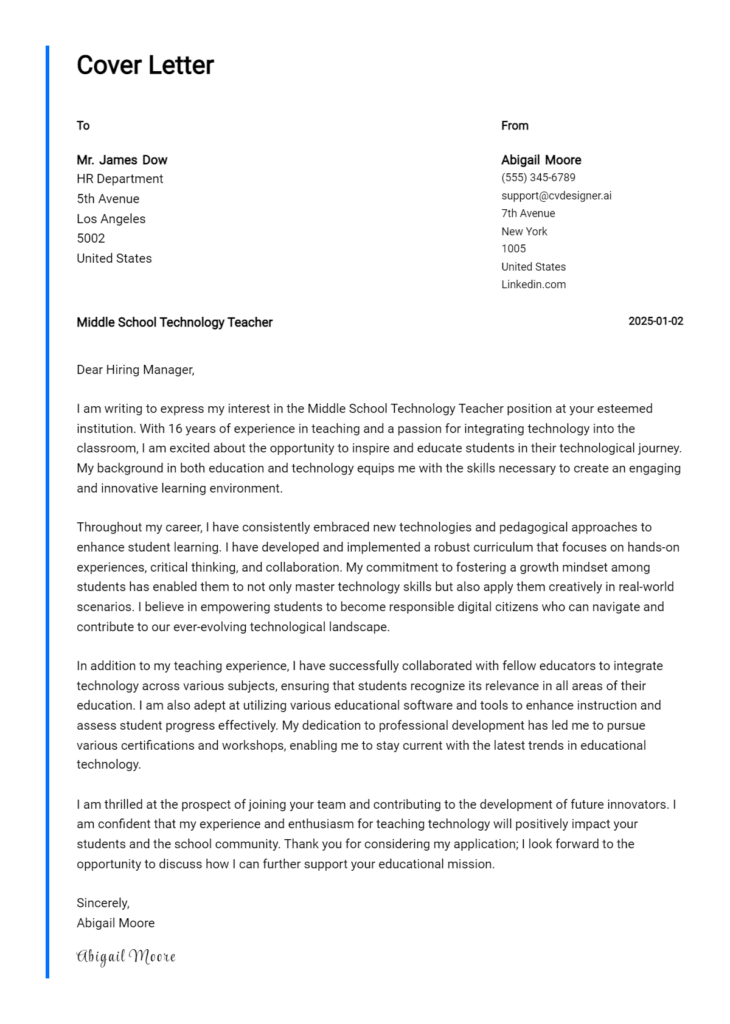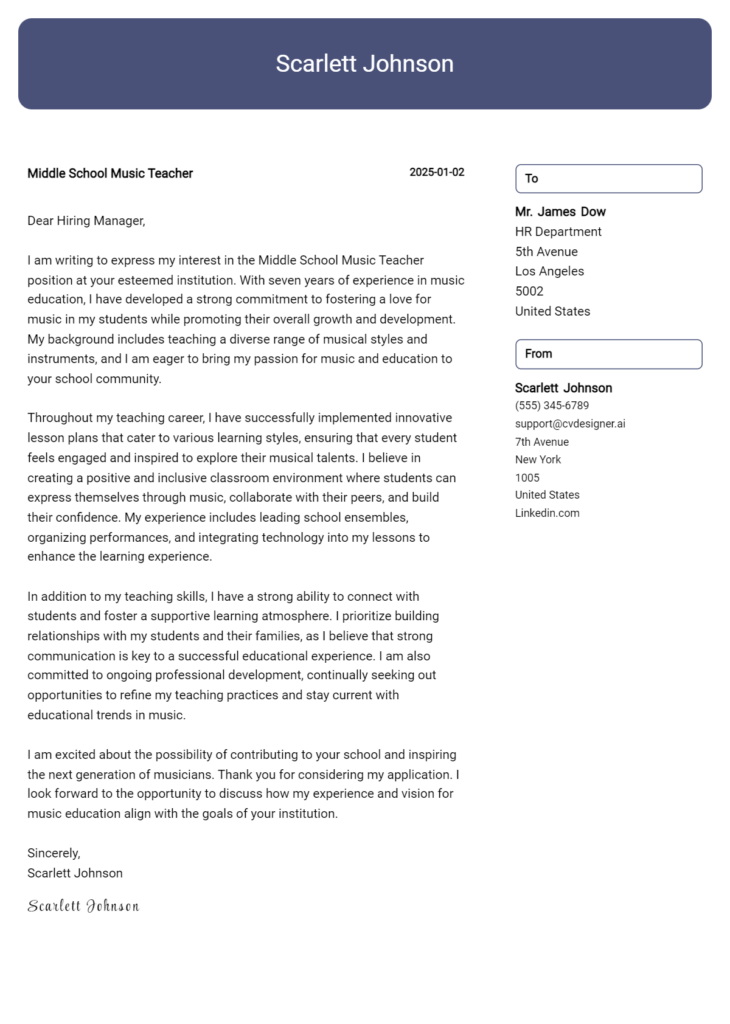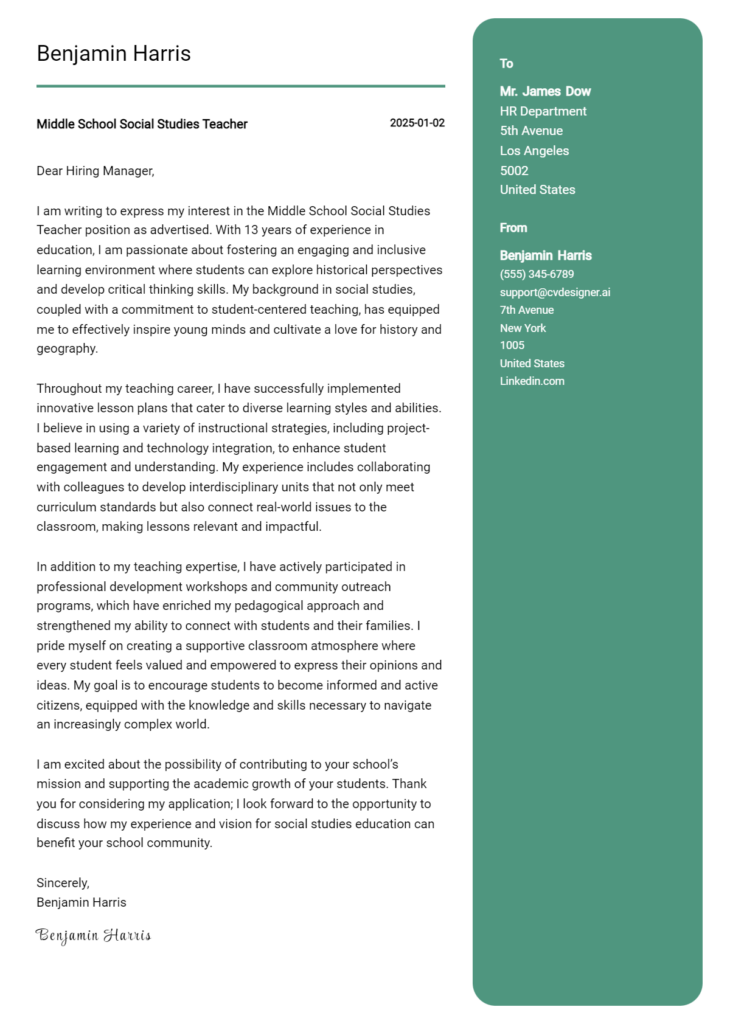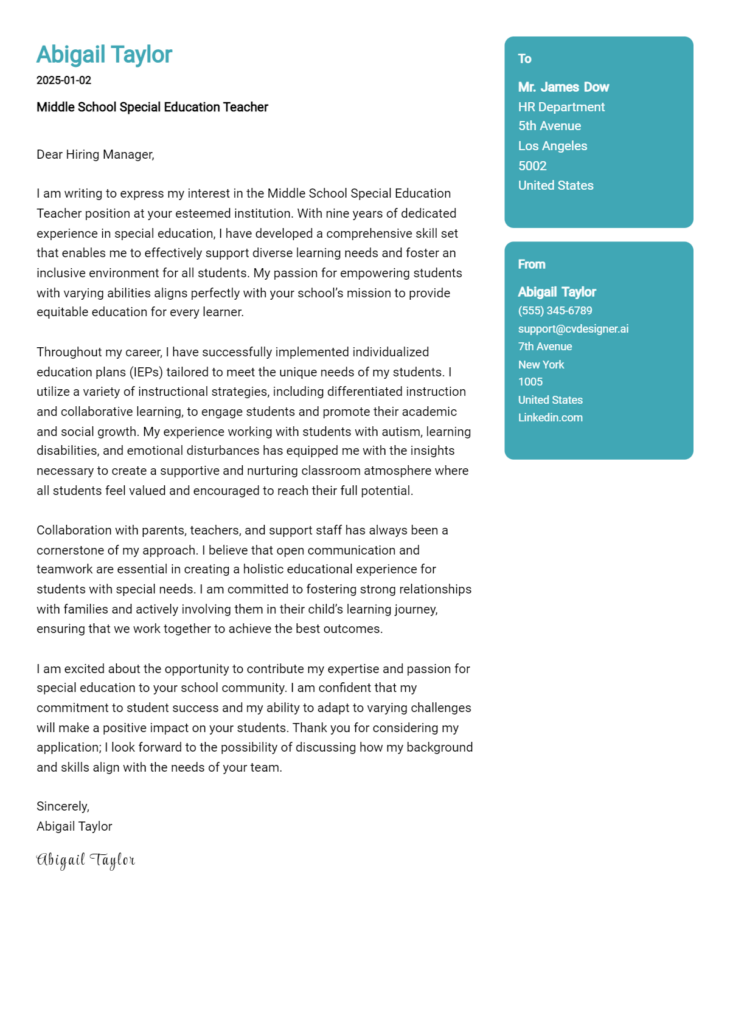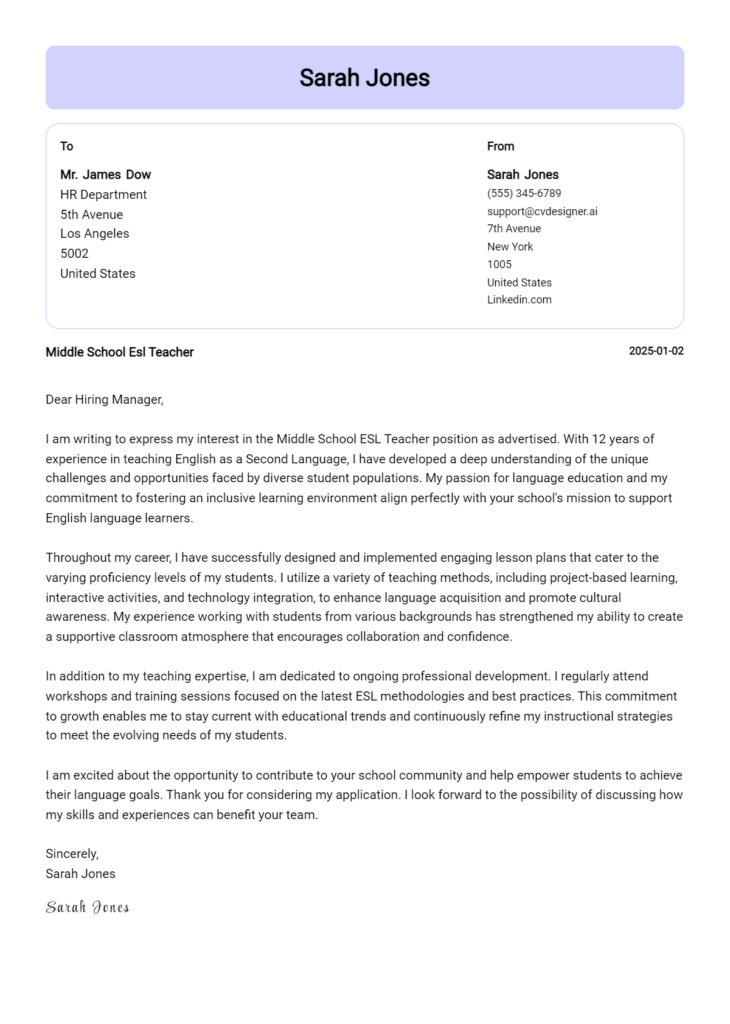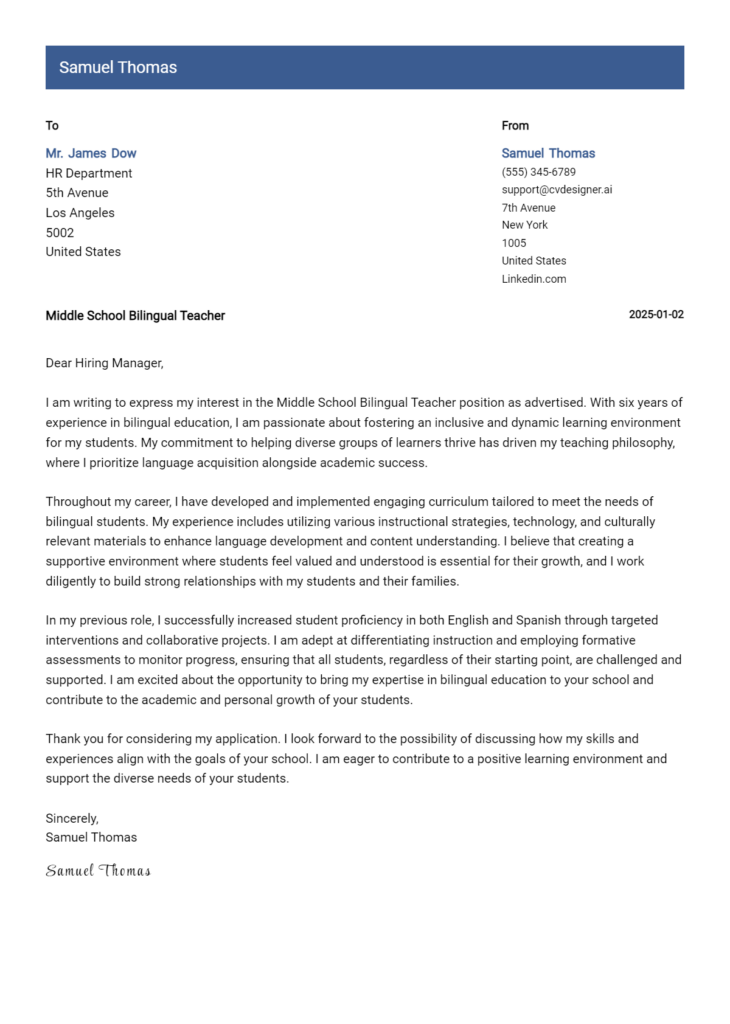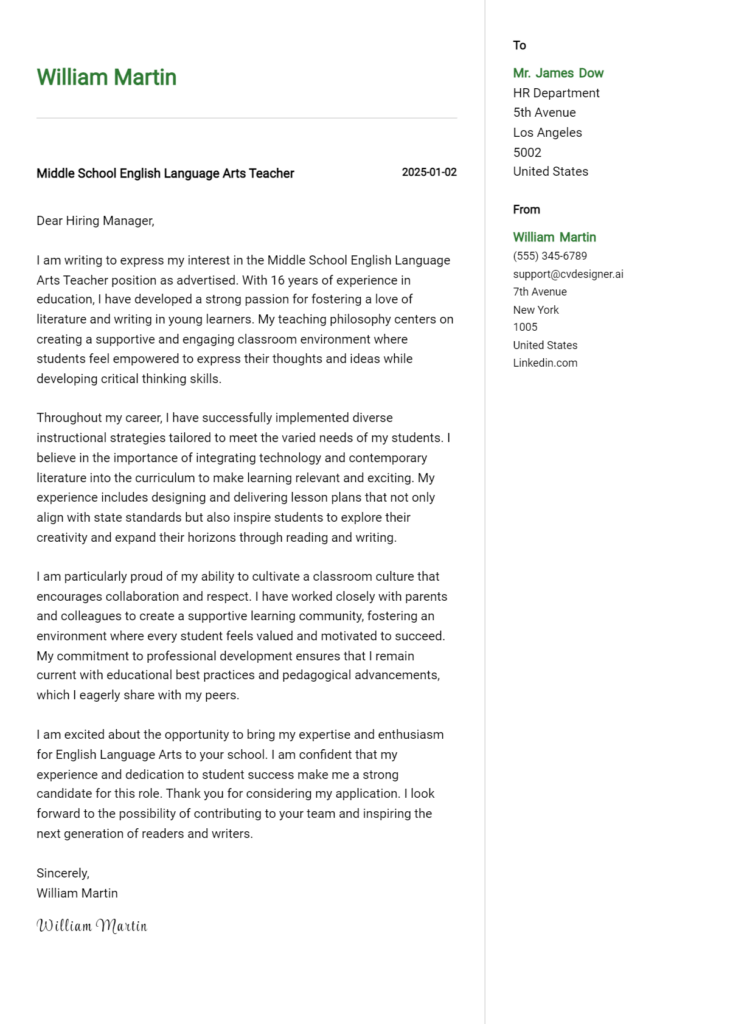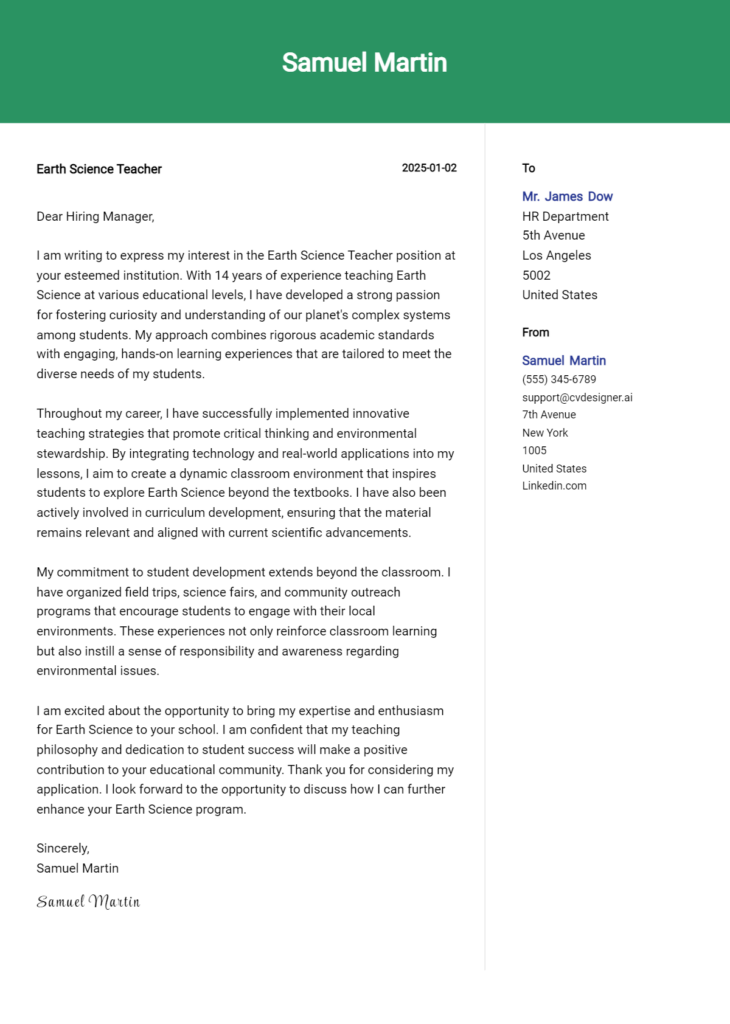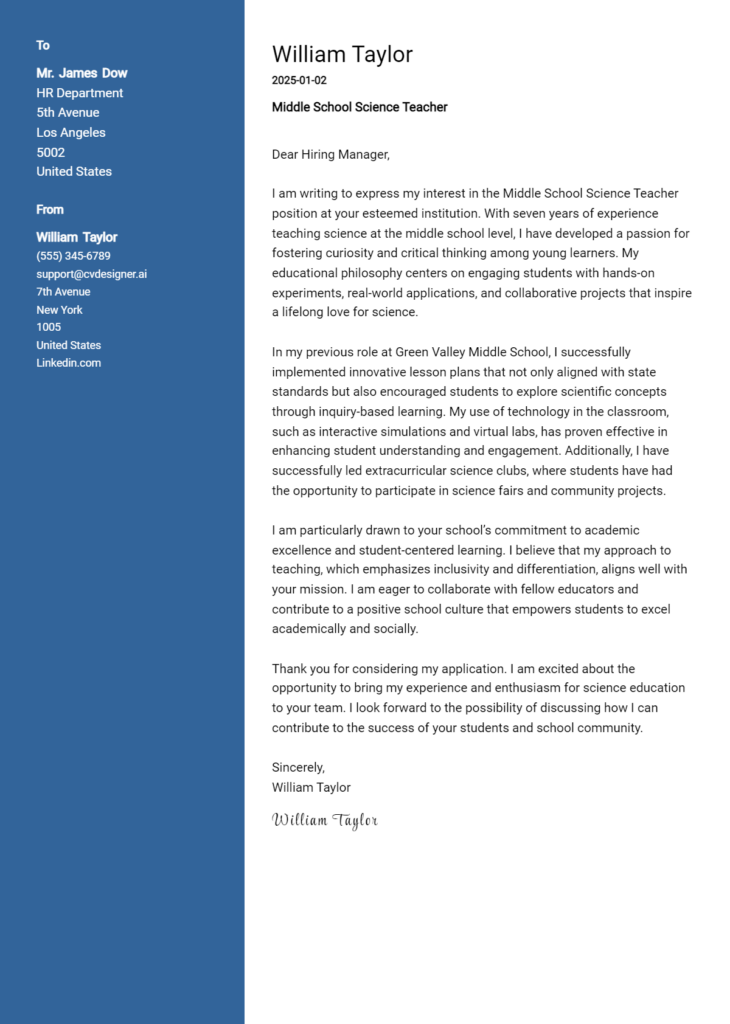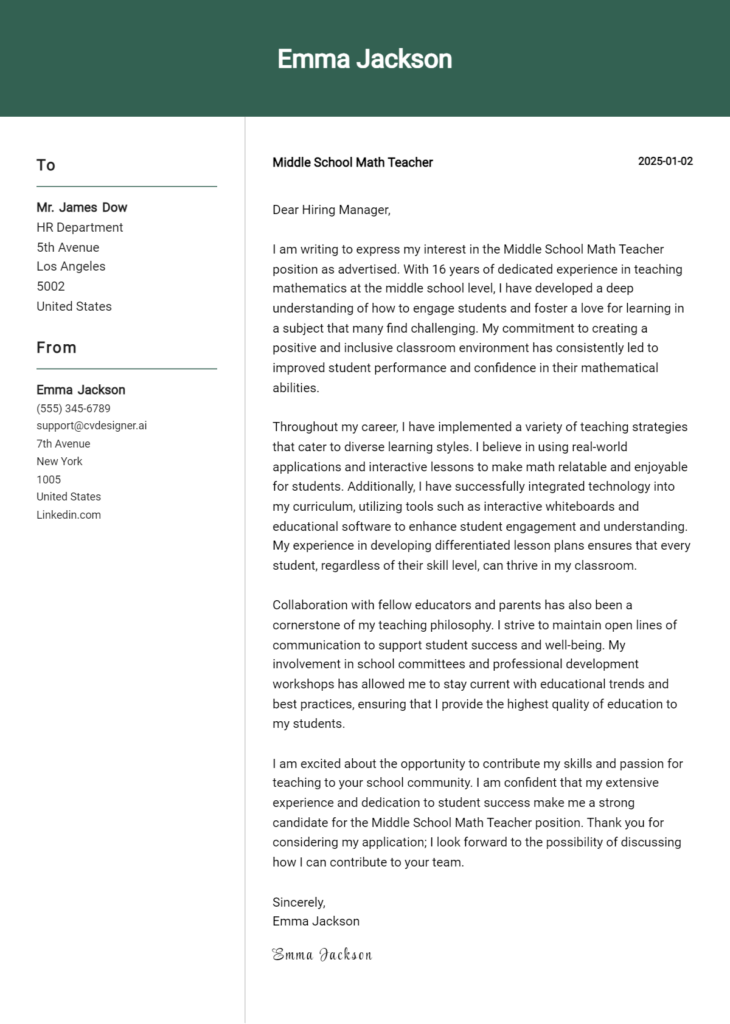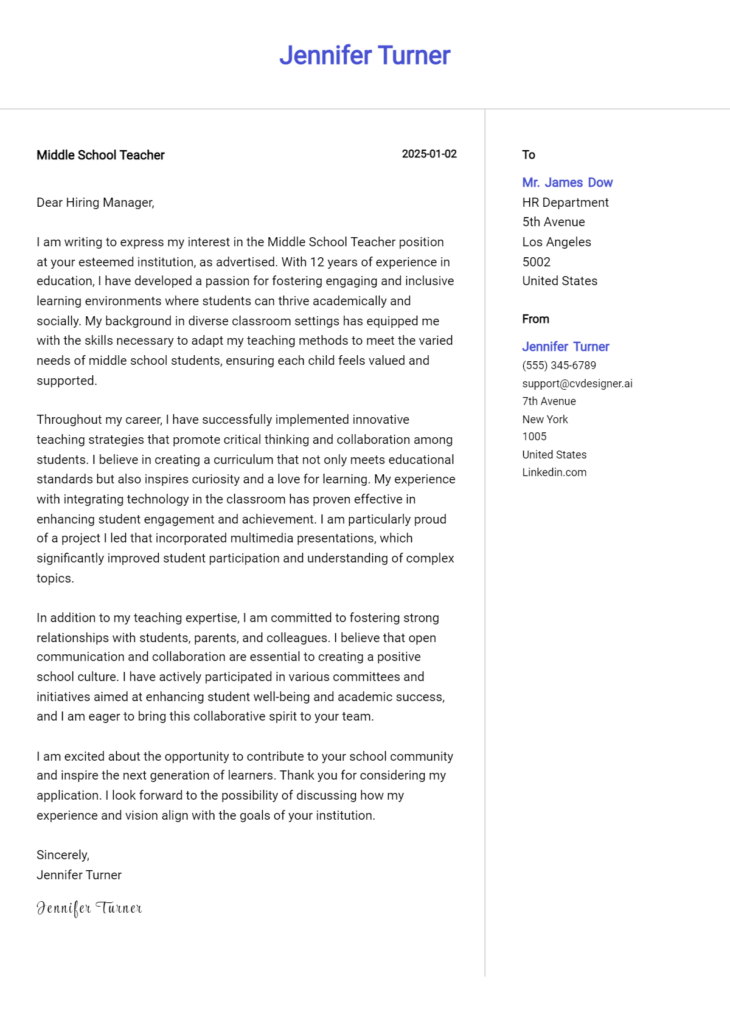Life Science Teacher Cover Letter Examples
Explore additional Life Science Teacher cover letter samples and guides and see what works for your level of experience or role.
How to Format a Life Science Teacher Cover Letter?
Crafting a compelling cover letter is essential for a Life Science Teacher, as it serves as your first opportunity to connect with potential employers. The format of your cover letter can significantly impact how your qualifications and passion for education are perceived. A well-structured cover letter not only showcases your teaching skills and scientific knowledge but also highlights your ability to communicate effectively—a crucial trait for educators.
In this guide, we will explore how to properly structure your cover letter, providing insights and examples tailored specifically for Life Science educators.
We will cover the essential components of a professional cover letter, including:
- Cover Letter Header
- Cover Letter Greeting
- Cover Letter Introduction
- Cover Letter Body
- Cover Letter Closing
Each section is vital in presenting your qualifications and dedication to teaching. Let’s delve into each part to help you create a standout cover letter that resonates with hiring committees in the field of life sciences.
Importance of the Cover Letter Header for a Life Science Teacher
The header of a cover letter is a critical component that sets the tone for your application. For a Life Science Teacher, clarity and professionalism are paramount, as it reflects your attention to detail and organizational skills—qualities essential for any educator. The header should include your contact information, the date, and the recipient's details (including their name, title, school, and address). This information not only provides the necessary context for your application but also ensures that your cover letter is easy to identify and reference. A well-structured header can make a positive first impression, while a poorly formatted one might lead to confusion or a negative perception.
Strong Example
Jane Doe 123 Science Lane Cityville, ST 12345 jane.doe@email.com (123) 456-7890 October 1, 2023 Mr. John Smith Principal Cityville High School 456 Education Ave Cityville, ST 12345
Weak Example
jane doe cityville 10/01/23 principal
The Importance of a Cover Letter Greeting for a Life Science Teacher
The greeting of your cover letter is crucial as it sets the tone for the entire document, making a strong first impression on the hiring manager. A well-crafted greeting demonstrates your professionalism and attention to detail. By addressing the hiring manager directly, you show that you have taken the time to personalize your application, which can help you stand out from other candidates. To enhance your greeting, avoid generic salutations like “To Whom It May Concern.” Instead, research to find the name of the hiring manager or relevant school administrator. If you cannot find a specific name, consider using a respectful and relevant title.
Strong Greeting Example
Dear Dr. Smith,
Weak Greeting Example
To Whom It May Concern,
The Importance of a Strong Cover Letter Introduction for a Life Science Teacher
A well-crafted cover letter introduction is crucial for a Life Science Teacher because it sets the tone for the entire application. This opening paragraph should not only grab the hiring manager's attention but also clearly express the candidate's enthusiasm for the role. Additionally, it should briefly highlight key skills or achievements that align with the demands of the position. A strong introduction can differentiate a candidate from others, making it essential to convey passion and expertise effectively.
Strong Example
Dear Hiring Committee, I am excited to apply for the Life Science Teacher position at [School Name], as I believe that fostering a passion for science in students is vital for their future success. With a Master's degree in Biological Sciences and over five years of teaching experience, I have successfully implemented innovative curriculum designs that have increased student engagement by 30%. I am eager to bring my expertise and enthusiasm to your esteemed institution and inspire the next generation of scientists.
Weak Example
To Whom It May Concern, I am applying for the Life Science Teacher job. I have a degree in science and think I would be a good fit. I have taught for a couple of years, but I am not sure how to make my classes interesting. I hope you consider my application.
Cover Letter Body for Life Science Teacher
The cover letter body serves as a critical component for a Life Science Teacher's application, showcasing the candidate's skills, experiences, and overall value to the educational institution. This section allows the applicant to highlight specific projects or accomplishments that demonstrate their expertise in life sciences, innovative teaching methods, and ability to engage students in the learning process. By providing concrete examples of successful curriculum development, student projects, or collaborative initiatives, the candidate can differentiate themselves from other applicants and illustrate their commitment to fostering a dynamic learning environment.
Strong Example
As a dedicated Life Science Teacher with over five years of experience, I successfully implemented an interactive project-based learning curriculum that increased student engagement by 30%. One notable project involved a hands-on investigation of local ecosystems, where students collected data and presented their findings at a community fair. This not only enhanced their understanding of ecological principles but also fostered a sense of stewardship for the environment. Additionally, I collaborated with fellow educators to develop interdisciplinary lessons that integrated technology, resulting in improved test scores across the board. My passion for teaching and my commitment to student success drive my desire to contribute to your school's mission of inspiring lifelong learners.
Weak Example
I have been a Life Science Teacher for a few years and I think I would be a good fit for your school. I teach biology and sometimes do fun experiments. I have also been involved in some projects with my students, but I'm not sure how successful they were. I really like teaching and I hope to help students learn more about science.
Importance of the Cover Letter Closing for a Life Science Teacher
The closing paragraph of a cover letter is crucial for leaving a lasting impression on hiring committees. It should succinctly summarize your qualifications and reiterate your enthusiasm for the role, while also encouraging the next steps such as reviewing your resume or scheduling an interview. A strong closing can reinforce your suitability for the position and express your eagerness to contribute to the educational environment, while a weak closing may come off as generic or disinterested.
Strong Example
Thank you for considering my application for the Life Science Teacher position at [School Name]. With my extensive background in biology and hands-on experience in engaging students through innovative teaching methods, I am excited about the opportunity to inspire the next generation of scientists. I look forward to the possibility of discussing how my skills align with the goals of your school. Please feel free to contact me to schedule an interview at your earliest convenience. I have attached my resume for your review. Thank you once again for your time and consideration.
Weak Example
Thanks for looking at my application. I hope to hear back soon. I have attached my resume, so you can check it out if you want. I think teaching is important, and I would like to work at your school.
These tips will help candidates craft an effective cover letter for a Life Science Teacher position. A well-written cover letter not only highlights your qualifications and experiences but also showcases your passion for teaching and learning. It's essential to convey your technical skills, problem-solving abilities, knowledge of the software development life cycle (SDLC), teamwork experience, and commitment to continuous learning. By following these tips, you can create a compelling narrative that resonates with hiring committees.
Cover Letter Writing Tips for Life Science Teacher
Highlight Technical Skills: Emphasize your technical skills related to life sciences, such as laboratory techniques, data analysis, and familiarity with scientific software. Use specific examples to demonstrate how you’ve applied these skills in previous teaching roles or projects. This can help establish your expertise and readiness for the role.
Showcase Problem-Solving Abilities: Life science education often involves addressing complex questions and challenges. Share examples of how you have successfully solved problems in the classroom or during research projects. This illustrates your critical thinking and adaptability, which are crucial for fostering a dynamic learning environment.
Demonstrate Knowledge of SDLC: If applicable, mention your understanding of the Software Development Life Cycle (SDLC) and how technology can enhance life science education. Explain how you integrate technology into your teaching methods, whether through software tools for simulations or data management, making your approach relevant to modern educational needs.
Emphasize Teamwork Experience: Teaching is often a collaborative effort. Highlight your experience working with other educators, support staff, and even students on projects or initiatives. Discuss how you have contributed to a team environment and what you learned from those experiences. This will show your ability to work well with others and contribute to the school community.
Express a Passion for Continuous Learning: The field of life sciences is constantly evolving. Convey your commitment to professional development and lifelong learning. Mention any courses, workshops, or conferences you’ve attended recently. This not only showcases your dedication to your own education but also serves as a model for your students.
For more resources, check out our cover letter templates and consider using a cover letter builder to streamline the writing process.
Common Mistakes to Avoid in a Life Science Teacher Cover Letter
Crafting a compelling cover letter is essential for standing out in the competitive field of education, particularly for a Life Science Teacher position. Avoiding common mistakes can significantly enhance your chances of making a positive impression on hiring committees. Here are some common pitfalls to watch out for:
Generic Content: Using a one-size-fits-all cover letter can make you seem uninterested. Tailor your letter to the specific school and position by incorporating relevant experiences and understanding of the school's values.
Poor Formatting: A cluttered or unprofessional layout can distract from your qualifications. Follow a clear cover letter format to ensure your letter is easy to read and visually appealing.
Neglecting the Introduction: Failing to grab the reader's attention in the opening can lead to a quick dismissal. Start with a strong opening statement that highlights your passion for teaching life sciences and your unique qualifications.
Overusing Jargon: While it's important to demonstrate your expertise, overloading your cover letter with technical terms can alienate the reader. Use clear, concise language to convey your ideas effectively.
Focusing Solely on Yourself: While your qualifications matter, it's crucial to show how you can contribute to the school's mission. Highlight how your teaching philosophy aligns with the institution's goals and how you can enhance the learning experience.
Ignoring Proofreading: Typos and grammatical errors can undermine your professionalism. Always proofread your letter multiple times and consider asking a colleague for feedback.
Lack of Enthusiasm: A lack of passion for the subject can be off-putting. Infuse your cover letter with genuine enthusiasm for teaching life sciences and inspire the reader with your vision for student engagement.
By steering clear of these common mistakes and taking advantage of helpful resources like cover letter examples, you can create a polished and persuasive cover letter that showcases your strengths as a Life Science Teacher.
Cover Letter FAQs for Life Science Teacher
What should I include in my cover letter as a Life Science Teacher?
In your cover letter, you should clearly outline your educational background, teaching philosophy, and relevant experience in life sciences. Start by introducing yourself and expressing your enthusiasm for the position. Highlight any degrees or certifications related to life sciences or education. Discuss your teaching methods and how you engage students with the subject matter. Include examples of successful projects or initiatives you've led and how they benefited students. Finally, convey your passion for fostering a love of science and critical thinking in students, and express your desire to contribute to the school's mission.
How can I make my cover letter stand out?
To make your cover letter stand out, personalize it for the specific school and position you are applying for. Research the school's programs, values, and community, and mention how your experiences align with them. Use storytelling to illustrate your teaching successes or challenges overcome, making your experiences relatable. Incorporate specific examples that demonstrate your skills in fostering student engagement and achievement in life sciences. Lastly, maintain a professional yet enthusiastic tone, and ensure your cover letter is free from grammatical errors.
Should I mention my teaching certifications in my cover letter?
Yes, mentioning your teaching certifications in your cover letter is essential. Certifications validate your qualifications and demonstrate your commitment to the profession. Include any relevant certifications, such as state teaching licenses, endorsements in life sciences, or specialized training in educational methodologies. Highlight how these certifications equip you with the knowledge and skills necessary to teach effectively. Additionally, if you have pursued any professional development opportunities, such as workshops or courses in life sciences education, mention these to showcase your dedication to continuous learning and improvement.
How long should my cover letter be?
Your cover letter should ideally be one page long, or about 3 to 4 paragraphs. Keep it concise while ensuring you convey all necessary information effectively. Start with a strong introduction that captures the reader's attention, followed by paragraphs detailing your qualifications, teaching philosophy, and relevant experiences. Use the final paragraph to express your enthusiasm for the position and your eagerness to contribute to the school community. Remember to use clear and professional language and to format your letter neatly for readability.
Build your Cover Letter in minutes
Use an AI-powered cover letter builder and have your letter done in 5 minutes. Just select your template and our software will guide you through the process.

